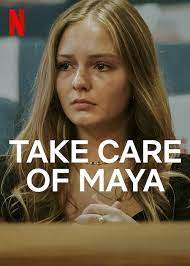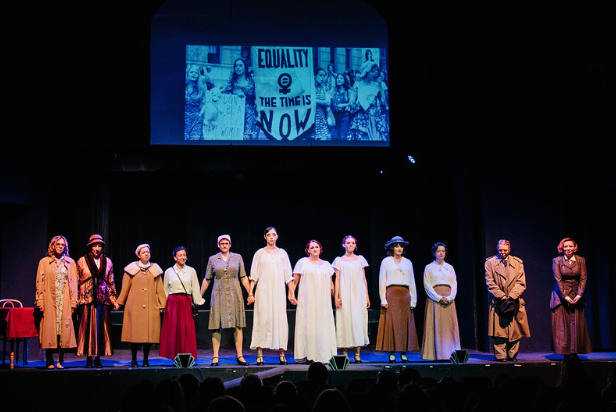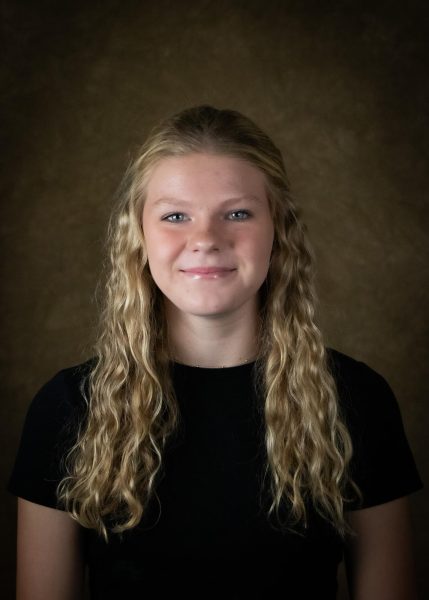 Take Care of Maya, a new documentary on Netflix, is taking over the world with its heartfelt story. This documentary is the tragic story of the Kowalski family and what they’ve gone through. Maya is the oldest daughter of the family and she is the one that suffered the most. Beata Kowalski, the mother of the family, said she could pinpoint the moment when everything started. It was the Fourth of July weekend in 2015, and Maya and her younger brother, Kyle, were playing with sparklers near their home in Venice, Fla. when she had a severe asthma attack. Beata then took Maya to the Sarasota Memorial Hospital, where she began to complain of a burning sensation in her legs and feet. Within weeks, she could barely walk. Her feet turned inward, she developed lesions and her legs could no longer support her body. At night, Beata could hear Maya’s cries from her bedroom on the other side of the house. Beata started researching and taking her to as many doctors as possible to figure out what was wrong with her.
Take Care of Maya, a new documentary on Netflix, is taking over the world with its heartfelt story. This documentary is the tragic story of the Kowalski family and what they’ve gone through. Maya is the oldest daughter of the family and she is the one that suffered the most. Beata Kowalski, the mother of the family, said she could pinpoint the moment when everything started. It was the Fourth of July weekend in 2015, and Maya and her younger brother, Kyle, were playing with sparklers near their home in Venice, Fla. when she had a severe asthma attack. Beata then took Maya to the Sarasota Memorial Hospital, where she began to complain of a burning sensation in her legs and feet. Within weeks, she could barely walk. Her feet turned inward, she developed lesions and her legs could no longer support her body. At night, Beata could hear Maya’s cries from her bedroom on the other side of the house. Beata started researching and taking her to as many doctors as possible to figure out what was wrong with her.
All of the hospitals and doctors couldn’t find a diagnosis and a lot of them blamed it on anxiety. They couldn’t tell if the pain was as serious as Maya was saying it was. Then, one of Beata’s patients recommended that they consult a local anesthesiologist named Anthony Kirkpatrick, who ran a center in Tampa that studied CRPS. Dr. Kirkpatrick then diagnosed Maya with Complex Regional Pain Syndrome (CRPS).
CRPS is a poorly understood disorder, which was also sometimes called “the suicide disease”, for its lack of viable treatment. Dr. Kirkpatrick came up with a treatment that could bring some relief to Maya, which was ketamine infusions. The drug, at the time, was best known as a very powerful “club drug”, but has also been used in emergency rooms. Over the next year, the Kowalskis took Maya for ketamine infusions every three to four weeks. Kirkpatrick charged $10,000 per four-day session, which was not covered by health insurance.
Maya’s doctors then informed her family about a procedure they had done plenty of times on other patients, which led them to be able to walk again. The procedure would take place at Hospital San José Tecnologico in Monterrey, Mexico. It was a five-day procedure that required her to be sedated and intubated to receive high-dose infusions of ketamine, which meant she would be put in a coma and have a large dose of ketamine put into her body. Her parents thought it was risky, but they were willing to do anything for their child. The procedure went well and Maya recovered fast, which led to great improvements in her condition. She started to gain upper body strength and could start moving more, but still had to be in a wheelchair.
On Oct. 6, 2016, Maya woke up complaining of severe abdominal pain. Jack, Maya’s father, rushed her to the Johns Hopkins All Children’s Hospital. Beata, an immigrant from Poland, came across very harshly by the front desk workers and doctors. She was very worried about her daughter and was trying to get what she wanted for her daughter. She told the nurse that Maya needed an ultrasound and a ketamine dose.
Sally Smith was said to be a pediatrician and a former staff member at All Children’s Hospital, and she started asking questions about Maya’s case history and what she had been doing. Beata started telling Sally what they had been going through, the long months and short nights with her daughter. They were willing to do anything to treat Maya’s condition. To the Kowalskis, ketamine wasn’t alarming, what was alarming was their daughter’s pain. Sally was also the Director of the Child Protection Team for Pinellas County’s Department of Children and Families and found her story unconvincing. Sally then requested to see Maya’s medical records from Dr. Kirkpatrick and wanted to speak with the person investigating the situation.
When Sally called him back she told him that she believed Maya was a victim of child abuse. Separately, Hanna, the doctor Kirkpatrick recommended to the Kalawaski family, advised Sally that Munchausen by proxy was a common misdiagnosis in CRPS cases. Hanna’s warnings were not included in the case Sally sent to the state, which urged that Maya be protected from her parents, in a case of child abuse.
A method of supporting a Munchausen-by-proxy diagnosis is a separation test: Remove the child from the offending parent and see if her health dramatically improves. So Maya was taken in by the John Hopkins Children’s Hospital and was under the care of the state. She was isolated for weeks and continued to report extreme pain. Even so, Sally was still not buying the CRPS story, and began to wonder if something else was happening that was not Munchausen by proxy. She then introduced doctors to secretly videotape Maya and asked nurses to try to catch Maya moving her legs or having any evidence of feeling better.
Sally was one of the 275 doctors nationwide to be certified in the field that year by the American Board of Pediatrics. They were trained to look for abuse and neglect in children. Even when All Children’s accepted Smith’s finding that Maya was faking her condition — going as far as to say that the strange bumps and lesions that continued to appear on her arms, legs and forehead were self-inflicted — it did not alter her custody status, and she remained separated from her parents.
The state’s shelter order was then revised to allow Jack, Maya’s father, some visitation rights and allow Beata to have contact through the phone by video and video calls. But by December, hospital staff were imposing additional restrictions at their own discretion. Maya’s social worker, Cathi Bedy, declined several of Beata’s FaceTime calls, which went from daily to once a week. Many of Maya’s aunts and uncles offered to supervise Jack’s appearances, but they were all rejected by the hospital for appearing to be “emotionally vested in the family,” as administrators later said. Bedy also restricted Maya’s tutors and educators from coming in. Even the family priest was denied access to her floor, leaving her almost completely isolated. The Kowalskis hired a lawyer to represent them in family-dependency court. At a custody hearing that month, the judge, Lee Haworth, seemed somewhat skeptical about Maya’s handling.
Beata offered everything she could, such as moving out of the house if that meant Maya could come home, but they wouldn’t listen. Beata was not allowed to see Maya on Christmas.
A week later, on Jan. 6, 2017, just before Maya was going to travel from the hospital to another hearing at court, Bedy and a different nurse entered her room and told her to take off her clothes. The hospital wanted to take photos of her before the proceeding. Maya refused to cooperate, even when Bedy told her that if she didn’t, she wouldn’t be able to go to the courthouse and see her family, especially her mother. Bedy forcibly started to remove her pants and shirt. Maya said that Bedy was pinning her down and she kept saying stop, but Bedy would not stop. She took photos of her without her consent in a training sports bra and shorts. The Kowalskis later learned that Bedy had been fired from a previous position managing foster-care children for Suncoast when she was arrested and charged with child abuse. Four fellow Suncoast employees called the police after they watched Bedy pin a 10-year-old boy to the ground with her knees, and cover his face with a blanket as he cried out that he couldn’t breathe. In a deposition, Bedy denied using her knees on the child.
Afterward, Maya got dressed and met up with her uncle outside of the hospital. It was the first time in months that Maya was outside of the fluorescent-colored hospital lights and room. She had spent Halloween, Christmas, New Year’s and her eleventh birthday in the hospital. At the courthouse, Maya wasn’t allowed to see her mom. After the court case, Beata and Jack returned home. Beata couldn’t stop crying, and Jack was worried about how pale Maya looked and how much weight she had lost. They were very worried about their daughter.
That night, Beata had gotten drunk. This was the first time Jack had seen her like that. The family was falling apart. Two days later Jack ran and jumped out of bed when he heard a scream. A relative who was visiting the house was yelling from the garage. Kyle was fast behind, but Jack held him back and told him to go to the other room. Inside the garage, Beata had hung herself. Her suicide note wrote, “I’m sorry but I no longer can take the pain being away from Maya and being treated like a criminal. I cannot watch my daughter suffer in pain and keep getting worse while my hands are tied by the state of FL and the judge!”
Maya eventually found out about her mother’s death and was returned back into her father’s care. Years later, the Kalawalki family went to court to get revenge back at what they had to go through. The process was long and there were many failed attempts while at court. No one was listening to their side of the story. After a long and treacherous journey, they finally made it.
A jury in Florida ordered a hospital to pay $261 million in damages to a family after the parents were accused of abusing their daughter and barred from seeing her during months of treatment. Jurors in Florida’s Twelfth Judicial Circuit in Sarasota County found documents against Johns Hopkins All Children’s Hospital in St. Petersburg, which shows an order of $211 million in compensatory damages and $50 million in punitive damages for false imprisonment, battery, medical negligence and other charges. Damages were awarded for infliction of emotional distress on the daughter in question, Maya Kowalski, and her mother, Beata Kowalski, who died by suicide in 2017. Maya’s father, Jack Kowalski, was named as a plaintiff in the case representing Maya and his wife’s estate, court documents showed. In the documentary, Maya said, “For the first time, I feel like I got justice.”
Overall the documentary was very heartfelt and intriguing, especially to learn about such a big hospital, and what they had done to a family and many others. The documentary was very visual and showed all the little details of Maya’s life. I would strongly suggest watching it even if you aren’t interested in health care, or court decisions, you will be interested.







